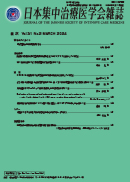Current issue
Displaying 1-11 of 11 articles from this issue
- |<
- <
- 1
- >
- >|
-
2024 Volume 31 Issue 2 Pages 133
Published: March 01, 2024
Released on J-STAGE: March 01, 2024
Download PDF (90K)
HIGHLIGHT IN THIS ISSUE
-
2024 Volume 31 Issue 2 Pages 135-136
Published: March 01, 2024
Released on J-STAGE: March 01, 2024
Download PDF (214K)
CASE REPORTS
-
Article type: case-report
2024 Volume 31 Issue 2 Pages 137-140
Published: March 01, 2024
Released on J-STAGE: March 01, 2024
Download PDF (291K) -
Article type: case-report
2024 Volume 31 Issue 2 Pages 141-144
Published: March 01, 2024
Released on J-STAGE: March 01, 2024
Download PDF (782K)
BRIEF REPORTS
-
Article type: brief-report
2024 Volume 31 Issue 2 Pages 145-146
Published: March 01, 2024
Released on J-STAGE: March 01, 2024
Download PDF (289K) -
Article type: brief-report
2024 Volume 31 Issue 2 Pages 147-149
Published: March 01, 2024
Released on J-STAGE: March 01, 2024
Download PDF (220K) -
Article type: brief-report
2024 Volume 31 Issue 2 Pages 150-151
Published: March 01, 2024
Released on J-STAGE: March 01, 2024
Download PDF (435K) -
Article type: brief-report
2024 Volume 31 Issue 2 Pages 152-153
Published: March 01, 2024
Released on J-STAGE: March 01, 2024
Download PDF (94K) -
Article type: brief-report
2024 Volume 31 Issue 2 Pages 154-155
Published: March 01, 2024
Released on J-STAGE: March 01, 2024
Download PDF (302K)
LETTER
-
2024 Volume 31 Issue 2 Pages 157
Published: March 01, 2024
Released on J-STAGE: March 01, 2024
Download PDF (152K)
COMMITTEE REPORT
-
2024 Volume 31 Issue 2 Pages 159-166
Published: March 01, 2024
Released on J-STAGE: March 01, 2024
Download PDF (444K)
- |<
- <
- 1
- >
- >|
